
The age of implementation. That is what the prominent Chinese venture capitalist Kai-Fu Lee calls the current stage of AI development. Computer scientists generally agree that robot overlords, if they ever come, are in the very distant future. That said, recent developments in deep learning have shown jaw-dropping pattern recognition and prediction capabilities. Deep learning algorithms will soon outperform humans in their ability to drive a car, diagnosis a disease, and translate text.
What’s behind recent advances in AI? The fundamental computer algorithms are not new. What is new is how they are applied to solve these problems. This has created a whole new field of engineers, calling themselves data scientists, skilled in the dark art of adapting these algorithms to particular problems. These practitioners blend expertise in particular application domains with expertise in computer science and statistics.
These data scientists are using AI to reshape industries. Taking the Internet of Things as an example, Gartner Group predicts that by 2022, over 80 percent of IoT projects will involve AI. According to Deloitte, in just the first eight months of 2017, AI-focused Internet of Things startups raised over $700 million.
Given the vast investment in intelligent systems, business leaders ask: Should I file for patent protection? Tough question, but this article lays out a framework for approaching that analysis with respect to intelligent systems.
Two critical factors for intelligent inventions
At a high level of generality, whether to patent an intelligent system involves the same inquiry as the question of whether to patent generally. Is the benefit worth the cost? This return on investment has to be placed the context of your overall IP strategy. Patents can be trophies, credentialing your technology to investors. They can be used as tools to discourage reciprocal IP suits from competitors. They can also be used for litigation or licensing revenue. How your IP fits into your overall business inevitably affects the decision on whether to pursue patent protection and how aggressive to be in securing patents.
Under that general backdrop, considerations specific to your particular invention take shape. For intelligent systems, two critical factors show up in almost every case.
The first factor is whether the invention is even eligible for patenting. In the wake of a 2014 Supreme Court case, Alice Corp. v. CLS Bank, patent eligibility, which once was relatively formulaic, has now become very uncertain for software patents. Recent caselaw has made it increasing difficult to patent software inventions and has made many AI inventions ineligible for patenting.
Patents cannot be secured on abstract ideas, mathematical algorithms, mental processes, or methods of organizing human activities. The fact that such mathematical algorithms or otherwise abstract ideas are implemented on a computer system is not enough to make them eligible for patent protection. That said, an application of such an algorithm can be eligible, but the patent must be specific on how it is applied. Now, courts are usually looking for improvements in the capabilities of the underlying computer system itself, and excluding those patents that merely use a computer as a tool. If that sounds vague, that’s because it is. Certainty is rarely available. But the odds are better for some inventions than others.
The second factor is visibility, that is, how easily infringement of your invention can be detected and how easily others can reverse engineer your invention. Much of an intelligent system’s operation occurs behind-the-scenes, making aspects difficult to observe from outside your organization. This lack of visibility has two effects. First, it may make it difficult to determine whether a competing product or service infringes your technology. Second, it raises the possibility of foregoing patenting in favor of trade secret protection.
Sometimes, it can be difficult to foresee whether an invention that is only practiced behind-the-scenes now will remain that way for a 20-year patent term. In software particularly, it’s common for others to copy proprietary systems in the form of open source projects. Determining whether an open source product practices your invention is usually straightforward, because the code is available for all to see.
Ultimately, whether a new enterprise developing an intelligent system decides to invest its scarce resources into filing a patent application tends to come down to these two questions: (1) Is my invention visible from the outside in a way that I could detect if someone else is practicing it? (2) Is my invention eligible for patenting? If you can be confident that the answer both questions is “yes,” you should likely apply for patent protection. If you can be confident that the answer to either question is no, you likely shouldn’t. But usually, 100% confidence in answering either question is impossible. As illustrated in the chart below, exactly how aggressive you should be depends on your own preferences and business strategy.
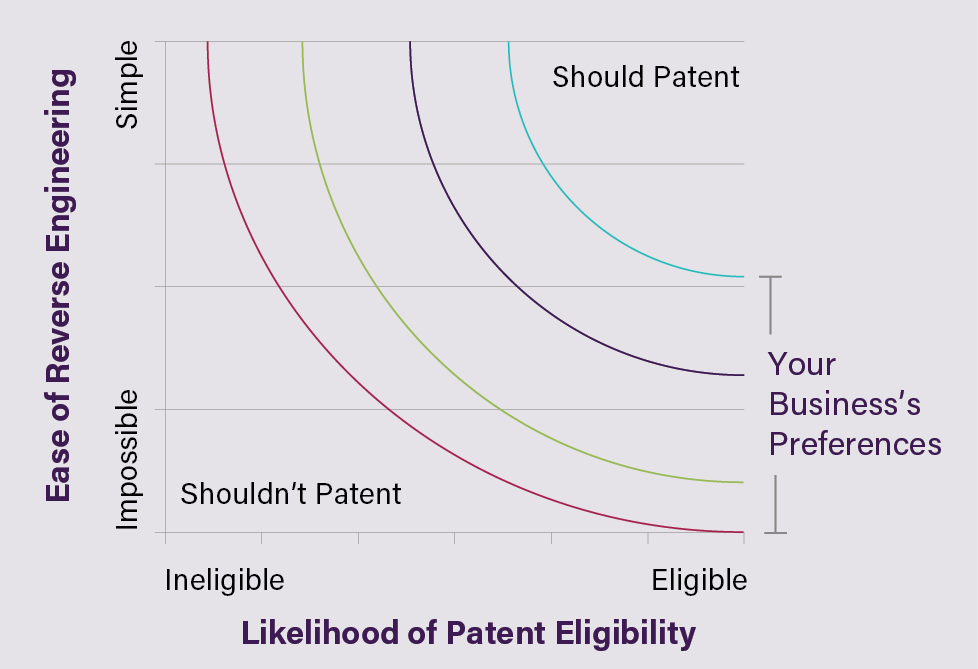
Breaking it down: what about my AI invention?
So what does this mean for my intelligent system? An AI system cannot be treated atomically. Every intelligent system has four different aspects: a user experience, a meaningful objective, intelligence creation, and an overall implementation and orchestration. Each represents an opportunity for creativity and problem solving, and each represents an opportunity for invention.
However, not all are equal candidates for patenting. In the remainder of this article, I address each of the four components and assess issues surrounding whether to pursue patent protection.
User experience
An intelligent system has a user experience, a way of interacting with the user and providing its output to the user. User feedback is necessary to improve the intelligence, and eliciting that feedback in a way that is unobtrusive can be challenging. Some intelligent systems can predict human behavior to the point of being outright creepy. Managing the creep factor is another area of engineering in the user experience.
Statistically, any machine learning algorithm will be wrong sometimes. It may perform better than humans. But, inevitably false positives and negatives will occur, and incorrect decisions will be made. How false positives and false negatives are handled can determine whether a self-driving car jars to a stop for a plastic shopping bag or hits a pedestrian at full-speed. Managing these errors in the output of a machine learning algorithm involves engineering of the user experience.
The cases have been mixed on patent eligibility of user interface inventions. In one case, Electric Power Group, LLC v. Alstrom S.A., the Federal Circuit—the intermediate appellate court handling most patent appeals—held ineligible a patent describing a UI that distilled a vast amount of power grid information to be “humanly comprehensible.” In another case, Core Wireless Licensing S.A.R.L. v. LG Electronics, Inc., the same court held that a patent describing a way to adapt information for small screens is eligible. In general, courts look for the specificity of the user interface solution and the degree to which it addresses a problem that it considers “technical.”
As the cases vary, the strength of eligibility arguments for intelligent user experiences also varies. Eligibility arguments may be stronger for improvements in handling of false positives and false negatives from the underlying algorithms. However, eligibility arguments may be weaker for those inventions related to the improvement of usability and making the intelligence experience less “creepy.”
While it can be difficult to tell whether an improvement to a user experience is eligible, determining whether an infringer practices your improvement to the user experience is usually quite simple. It’s usually easy to understand just through observing the operation of a competing product or service.
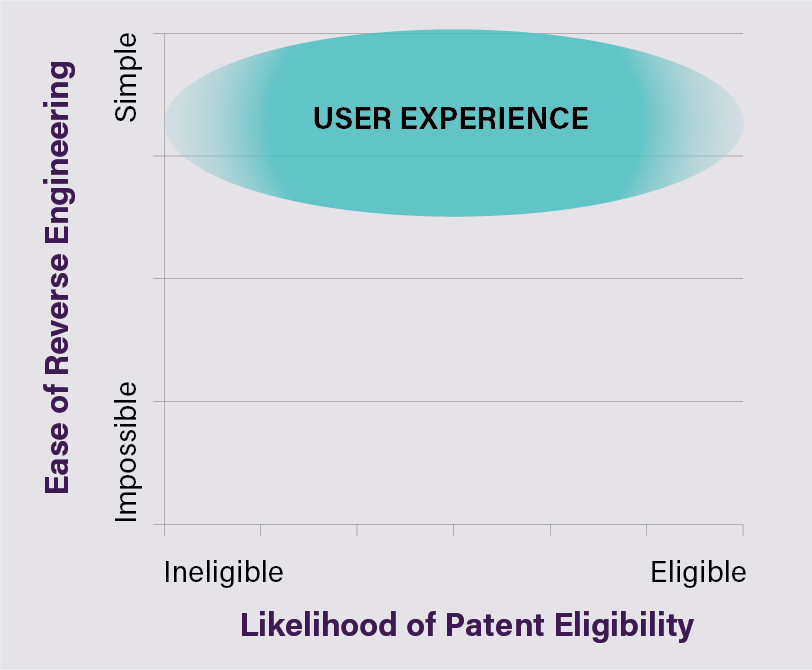
Meaningful objective
An intelligent system must have a meaningful objective, a goal that it seeks to attain. For example, an intelligent system may be trained to maximize the click-through rate of ads shown to users or trained to detect fraud in health insurance claims. Sounds straightforward, but in practice identifying a goal that is measurable and effective can be very difficult.
From the outside, the objective is not quite as easy to discern as the user experience. But, given enough data and analysis of how a model works, reverse engineering of an intelligent system’s objective is often possible. Also, companies often just voluntarily disclose aspects of their objectives in explaining the systems that they are developing and promoting. They are often presented as a competitive advantage. Thus, while not as transparent as the user experience, in practice it is very difficult to maintain an intelligent system’s objective as a trade secret.
That said, it doesn’t necessarily mean that a patent covering an AI objective is a good candidate for patenting. Usually, it is relatively easy to characterize these objectives as abstract ideas. Many times these objectives address methods of organizing and optimizing human activity. It may be impossible to solve some workflow optimization problems without help of machine learning. Despite worthy research in this area, patent eligibility may be very difficult.
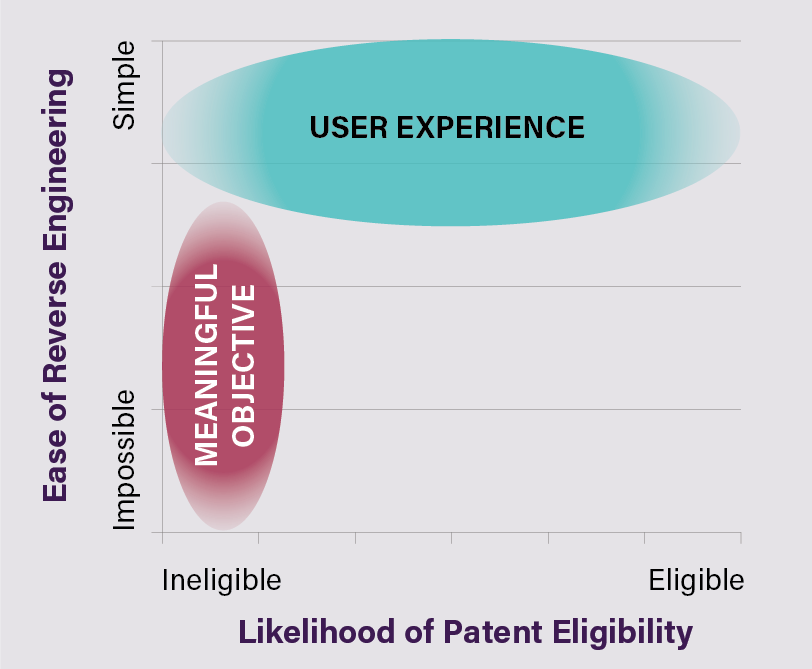
Intelligence creation
An intelligent system needs a way to create the intelligence, a way to train the algorithm to its goal. Data science can be a kind of dark art of training a model in just the right manner. There are often challenges in selecting the right inputs, called features, and presenting them in a way so that a machine learning algorithm can find hidden patterns. Data scientists coined the term “feature engineering” to describe the process of addressing these challenges.
Big data is the fuel powering machine learning, and data scientists often say that there’s no such thing as too much data. That may be true, but data can lack adequate diversity. Also, a model can be over-trained, so that it only knows how to deal with the training set, or under-trained, so that it has not had enough exposure to different examples to provide statistically significant outputs. Solving these problems provides much room for invention.
That said, reverse engineering these training algorithms is usually close to impossible. This is in part because training algorithms are often only used in product development and products are delivered fully trained. Any feature engineering that goes into the training data usually is not visible from the resulting trained model. In addition, feature engineering techniques tend to smack of mathematical algorithms. But, it may be possible to get patents by emphasizing technological benefits that result.
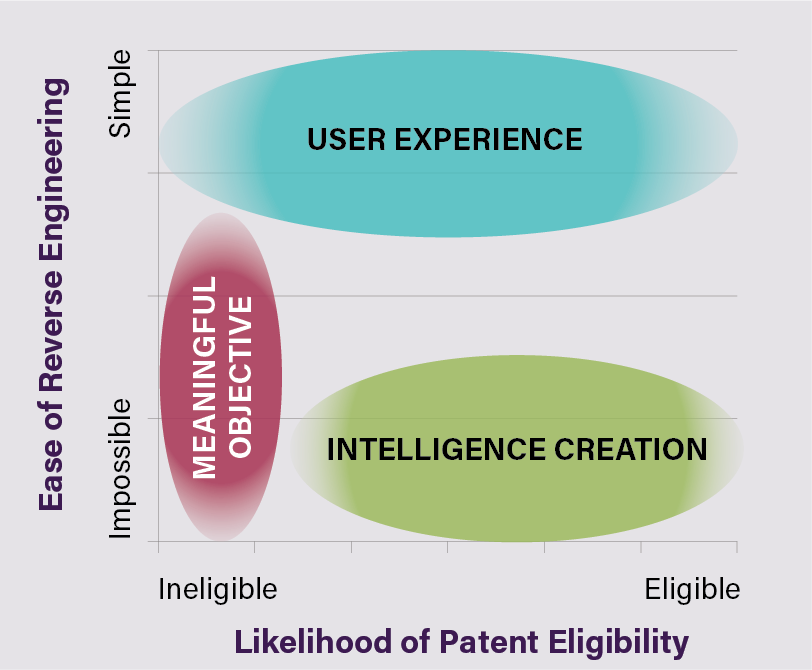
Overall implementation and orchestration
The overall implementation and orchestration of the intelligence provides an additional area for invention. In implementing an intelligent system, a designer needs to decide, for example, how to distribute and operate the intelligent model efficiently, to gather telemetry, and to assess risk and abuse of feedback loops. Each of these aspects is an opportunity for patenting.
Visibility of these inventions is going to vary. It may be easier to detect infringement of the system that’s orchestrated across a number of devices such as IoT devices or client devices. On the other hand, to the extent the overall implementation and orchestration occurs strictly on the backend, detecting infringement may be difficult.
As mentioned above, while abstract ideas are ineligible for patenting, particular applications of those abstract ideas are eligible. That said, the application must deal with particular technological problems that arise during implementation. In that sense, patents directed to improvements in the way an intelligent system is implemented may be the most likely to be eligible for patenting.
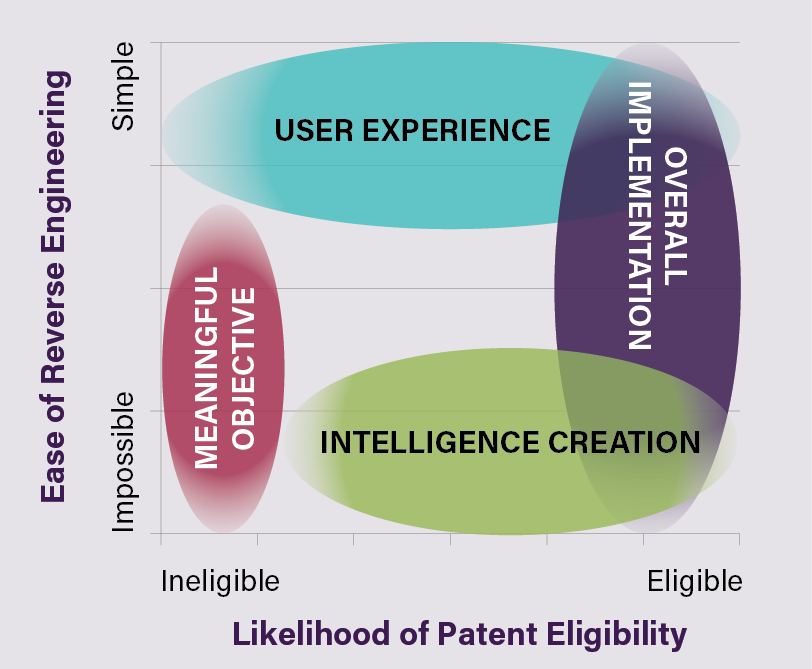
Putting it all together
The analysis comes down to the specifics of each case. In general, patents addressing the user experience and overall implementation and orchestration of an intelligent system may be the best candidates for patenting. These, still, require finesse.
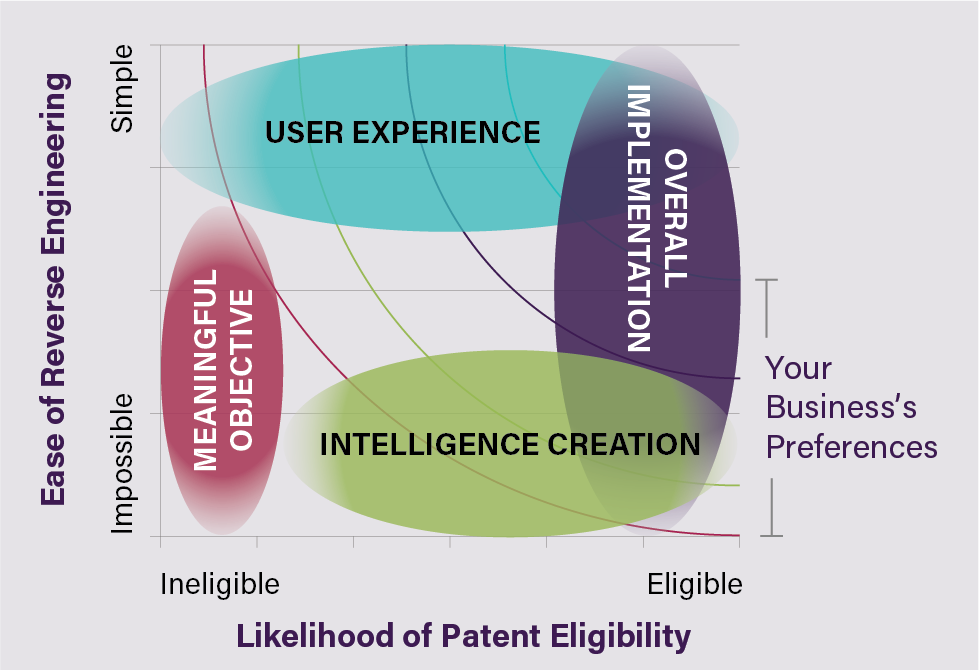
To the extent your invention involves a new objective, it may be better to combine the objective with other aspects to support patent eligibility arguments. Also, consider pursuing protection outside the US, where eligibility for software patents is, at least right now, more liberal.
On the intelligence creation front, inventors should also consider how important the ability to detect infringement is to their business. For many startup enterprises, litigation and licensing is unlikely. Those enterprises tend to file patents mostly to credential their business to investors. In that case, the ability to detect infringement may be less important. This is where your business’s overall IP strategy can come into consideration.
Also, inventors should consider whether trade secret protection is adequate. Congress recently passed legislation to strengthen trade secret protection in the United States. Europe also promulgated an analogous regulation.
Strategies exist in the U.S. to avoid publication while the patent application is pending. These strategies allow a company to maintain its trade secrets while pursuing patent protection.
Ultimately, your business’s IP strategy must align with your business strategy. Given the vast sums now being poured into AI development, the protection of that investment deserves careful strategic thinking.
This article is for educational purposes only and does not constitute legal advice. The views expressed are those of the author(s) and do not necessarily reflect those of Sterne Kessler Goldstein & Fox PLLC or any other organization or individual.
About the Author
 Joseph E. Mutschelknaus is a director in at Sterne, Kessler, Goldstein & Fox, P.L.L.C. where he prosecutes post-issuance proceedings and patent applications before the United States Patent & Trademark Office. He also assists with district court litigation and licensing issues.
Joseph E. Mutschelknaus is a director in at Sterne, Kessler, Goldstein & Fox, P.L.L.C. where he prosecutes post-issuance proceedings and patent applications before the United States Patent & Trademark Office. He also assists with district court litigation and licensing issues.


